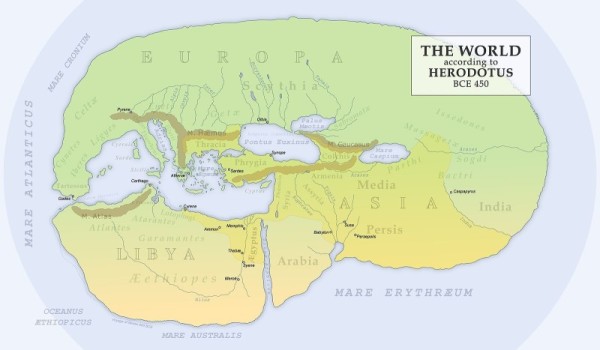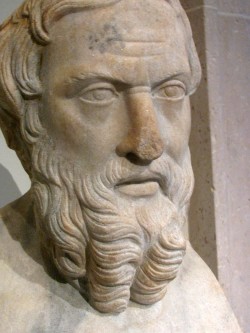And one thing I shall tell of, which few of those who go in ships to Egypt have observed, and it is this . . . .

Translated by George C. Macaulay — our special project presenting the complete Herodotus with URLs for all of those people, places, events, and things which baffles and discourages modern readers.
Previously on Herodotus
5. Now by this way only is there a known entrance to Egypt: for from Phoenicia to the borders of the city of Cadytis belongs to the Syrians who are called of Palestine, and from Cadytis, which is a city I suppose not much less than Sardis, from this city the trading stations on the sea- coast as far as the city of Ienysos belong to the king of Arabia, and then from Ienysos again the country belongs to the Syrians as far as the Serbonian lake, along the side of which Mount Casion extends towards the Sea. After that, from the Serbonian lake, in which the story goes that Typhon is concealed, from this point onwards the land is Egypt. Now the region which lies between the city of Ienysos on the one hand and Mount Casion and the Serbonian lake on the other, which is of no small extent but as much as a three days’ journey, is grievously destitute of water.[1]
6. And one thing I shall tell of, which few of those who go in ships to Egypt have observed, and it is this: — into Egypt from all parts of Hellas and also from Phoenicia are brought twice every year earthenware jars full of wine, and yet it may almost be said that you cannot see there one single empty wine-jar. In what manner, then, it will be asked, are they used up? This also I will tell. The head-man of each place must collect all the earthenware jars from his own town and convey them to Memphis, and those at Memphis must fill them with water and convey them to these same waterless regions of Syria: this the jars which come regularly to Egypt and are emptied there, are carried to Syria to be added to that which has come before.
7. It was the Persians who thus prepared this approach to Egypt, furnishing it with water in the manner which has been said, from the time when they first took possession of Egypt: but at the time of which I speak, seeing that water was not yet provided, Cambyses, in accordance with what he was told by his Halicarnassian guest, sent envoys to the Arabian king and from him asked and obtained the safe passage, having given him pledges of friendship and received them from him in return.
8. Now the Arabians have respect for pledges of friendship as much as those men in all the world who regard them most; and they give them in the following manner: — A man different from those who desire to give the pledges to one another, standing in the midst between the two, cuts with a sharp stone the inner parts of the hands, along by the thumbs, of those who are giving the pledges to one another, and then he takes a thread from the cloak of each one and smears with the blood seven stones laid in the midst between them; and as he does this he calls upon Dionysos and Urania. When the man has completed these ceremonies, he who has given the pledges commends to the care of his friends the stranger (or the fellow-tribesman, if he is giving the pledges to one who is a member of his tribe), and the friends think it right that they also should have regard for the pledges given. Of gods they believe in Dionysos and Urania alone: moreover they say that the cutting of their hair is done after the same fashion as that of Dionysos himself; and they cut their hair in a circle round, shaving away the hair of the temples. Now they call Dionysos Orotalt and Urania they call Alilat.

CC BY-SA 2.0 image from Wikipedia.
9. So then when the Arabian king had given the pledge of friendship to the men who had come to him from Cambyses, he contrived as follows: — he took skins of camels and filled them with water and loaded them upon the backs of all the living camels that he had; and having so done he drove them to the waterless region and there awaited the army of Cambyses. This which has been related is the more credible of the accounts given, but the less credible must also be related, since it is a current account. There is a great river in Arabia called Corys [2], and this runs out into the Sea which is called Erythraian. From this river then it is said that the king of the Arabians, having got a conduit pipe made by sewing together raw ox-hides and other skins, of such a length as to reach to the waterless region, conducted the water through these forsooth, and had great cisterns dug in the waterless region, that they might receive the water and preserve it. Now it is a journey of twelve days from the river to this waterless region; and moreover the story says that he conducted the water by three conduit-pipes to three different parts of it.
10. Meanwhile Psammenitos the son of Amasis was encamped at the Pelusian mouth of the Nile waiting for the coming of Cambyses: for Cambyses did not find Amasis yet living when he marched upon Egypt, but Amasis had died after having reigned forty and four years during which no great misfortune had befallen him: and when he had died and had been embalmed he was buried in the burial-place in the temple, which he had built for himself. Now when Psammenitos son of Amasis was reigning as king, there happened to the Egyptians a prodigy, the greatest that had ever happened: for rain fell at Thebes in Egypt, where never before had rain fallen nor afterwards down to my time, as the Thebans themselves say; for in the upper parts of Egypt no rain falls at all: but at the time of which I speak rain fell at Thebes in a drizzling shower.
– Herodotus, Book III
Note
[1] Herodotus is describing the north coast of the Sinai Peninsula.
[2] No such river exists.
| <—Previous | Master List | Next—> |
Herodotus made his living by being interesting. In a world where most people did not read and could not afford to buy a book even if they could, they would pay to listen to Herodotus recite from his books. They would not pay to be bored. In that world, the names that populate his stories would have some general familiarity to his audience. Their obscurity to us is a barrier that this series seeks to break down.
MORE INFORMATION
MAP LIBRARY
Because of lack of detail in maps as embedded images, we are providing links instead, enabling readers to view them full screen.

Leave a Reply
You must be logged in to post a comment.